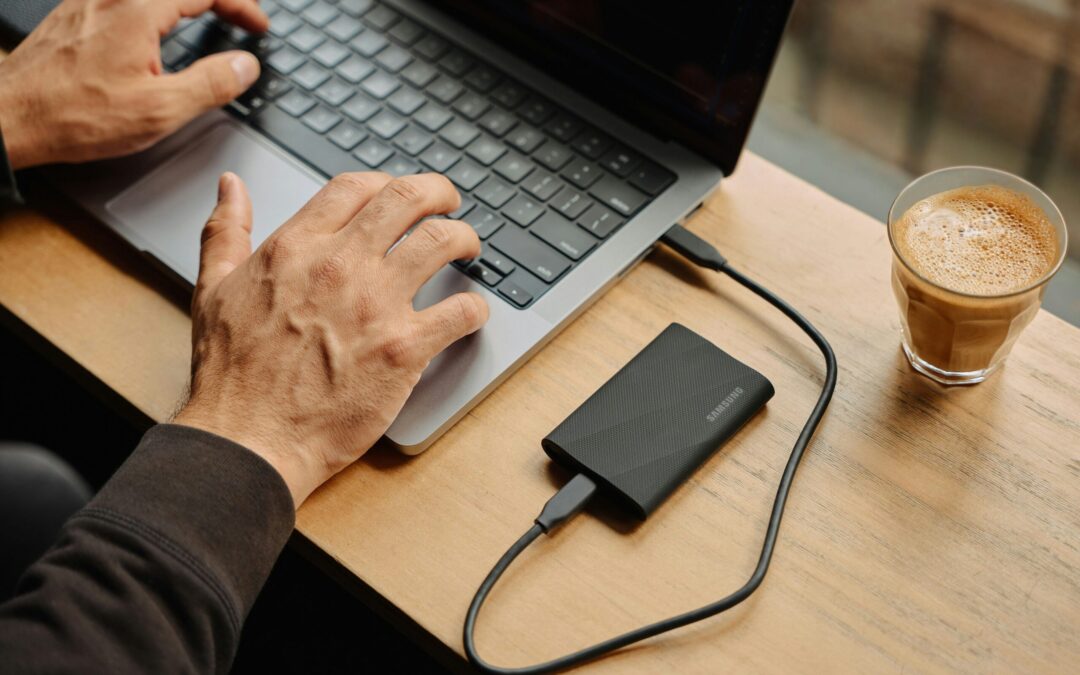Storing and Transferring files is something that most of us do every day. It might be saving a presentation for a big meeting or sending your line manager your expenses in a spreadsheet or sending an order over to a supplier, anything we save or send on a computer involves storing and transferring files. However, the safety of files can be really tough to maintain.
In IT circles we use the term data “at rest” when we talk about it being stored and “in transit” when it’s being transferred or moved. It’s important that in both cases it’s done securely. In this guide, we are going to help you protect your files and explore ways to store and send files securely.
Secure file storage (at rest)
There are multiple different types of storage. They all have different ways to access them but a key thing to make them secure is encryption. Encryption uses some cleaver maths involving prime numbers to make the data unreadable to someone who does not have the correct “key”. The key is normally kept safe using your password and normally the process of unlocking the data happens transparently to you the user.
Types of secure storage
Files can be stored securely in various ways, as listed below.
- Your internal laptop / computer hard drive
- Cloud file storage
- External hard drives
- USB drives
With all of the above the key is that they need to be encrypted.
Why is secure file storage important?
I think this is fairly obvious but secure storage helps to keeps your information private. If someone steals your laptop, external disk or USB memory stick then they could easily get access to your data. Encryption doesn’t stop thieves from stealing your data but it does stop them for being able to see it. It also helps you follow laws about data protection.
Risks of unsecured storage
Unsecured files can lead to huge troubles, including but not limited to the following:
- Identity theft
- Financial loss
- Privacy breaches
These risks give a reason why secure storage is important. You need to protect your personal and work files. If you are operating in the EU / UK and are storing personal data then you have to consider GDPR and could be liable to some fairly significant fines if you loose data that is not secured.
How Can I Make My File Storage Safer?
You can do so many things to make your storage safer, such as:
- Using strong passwords
- Enabling two-factor authentication
- Check that encryption is in place and that it meets current standards
- Keeping your software up to date frequently
Assuming that your encryption is done correctly then the only way to access the data is with your username, password and (hopefully…) two factor authentication. Making those 3 things as good as they can be will significantly increase your security.
What about file transfers?
When you are moving data or files from one place to another we say that it is being transferred or is “in transit”. Secure file transfer is a way of sending files safely between individuals or devices. It prevents unauthorized access to files and prohibits modification of files while in transit.
Common secure transfer methods
There are several ways to securely transfer files. They include:
- Secure file-sharing services
- Encrypted email attachments
- Physically passing an (encrypted…) hard drive or memory stick (or floppy disk…)
- Secure FTP (SFTP)
- Virtual Private Networks (VPNs)
Each of the above methods provides additional security when you transfer your files. They ensure your data is secured during transfer.
How to Transfer Files Safely?
Transfer of files safely can be done by following the steps outlined below:
- Select a secure method of transfer
- Encrypt the file before you send it
- Give strong passwords for file access
- Authenticate the recipient
- Send the access details separately
These steps will keep your files safer while in transit. This way, they can only be accessed by those whom they are intended for.
How to email attachments safely
Most people are not aware but email is, for the main part, NOT encrypted as it moves over the internet. It’s like sending all of your mail on a postcard with no envelope. As a result attaching files to an email poses a risk. Here’s how to make it safer:
- Encrypt important attachments
- Use a secure email service
- Avoid writing sensitive information in the body of an email
- Double-check the recipient’s email address
These will help protect your email attachments from being viewed by others. Here are some of the common file storage and transfer mistakes:
- Thinking that “zipping” things with a password = encrypyion (it does not)
- Poor password creation (see above)
- Forgetting to encrypt the files
- Not updating the security software
- Giving out access information with the files
These can expose your files to unnecessary risks.
How to avoid these mistakes
You will avoid these errors by:
- Setting up a password manager
- Setting up automatic encryption
- Allowing auto-updates
- Sending access info separately from the files
These steps keep you off the common security mistakes. They make the storage and transfer of your files safer.
Ready to Secure Your Files?
I help businesses in Stone, Stoke and Stafford (occasionally further afield as well) to make sure they are following best practices when storing and sending data or files. Need help with secure file storage? Feel free to reach out today and let us walk you through setting up safe systems for your files. Don’t wait until it’s too late; take the next step in protecting critical data.
—


Recent Comments